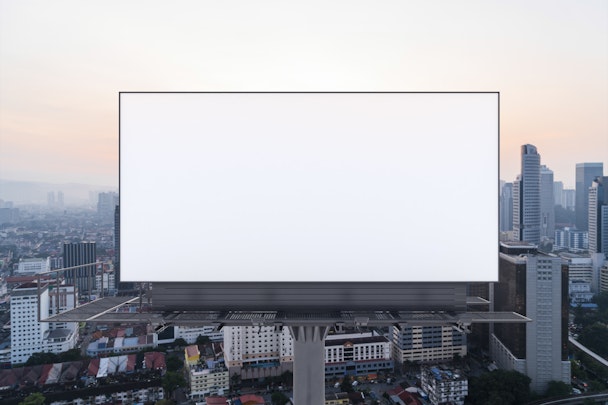Out-of-home: a timeless strategy for advertisers
Anna Bager, President and CEO of the Out of Home Advertising Association of America (OAAA), offers some insights into why brands should continue to invest in “the oldest — and newest — creative medium out there.”

OOH advertising revenue increased dramatically in 2022, according to the OAAA. / Adobe Stock
Out-of-home (OOH) advertising may be the oldest mass advertising medium, but it’s also the most adaptive, dynamic, artistic and effective. From the simplest sign postings to 3D anamorphic screens, OOH has withstood the test of time. And as brands, agencies and media companies work towards integrating and adapting to the latest emerging technologies, OOH has been evolving right alongside them.
Fashion retailer Revolve, for example, recently captured global attention for what they called “the world’s first AI-generated billboard campaign.” To celebrate its 20th anniversary, Revolve and its agency, Maison.Meta, used generative AI image-making tool Midjourney to produce the “Big Trip” campaign, juxtaposing styles from the company’s past with a look ahead to the brand’s future.
Advertisement
Generative AI tools like Midjourney and text-focused ChatGPT promise — or threaten, depending on your perspective — to change everything from the way we search for online information to how copywriters and software engineers produce text and code, respectively. It’s no surprise, then, that big brands like Amazon, Coca Cola, Disney, Netflix and Nike are experimenting with this emerging technology in their marketing campaigns.
While generative AI is still in the “shiny new toy” phase, OOH has the innate ability to connect new ideas to practical use cases. No matter what, OOH’s longevity has proven its versatility and ability to absorb the shock of the new. It always has. And that’s why brands and agencies are leaning into this medium — which existed long before TV or the internet — to “future-proof” their businesses.
Advertisement
A conversation-starter
When it comes to brand awareness and commerce, Kevin McLoughlin, T-Mobile’s CMO Consumer, SVP, extolled OOH ads as a key element in driving customers to the brand’s retail locations. After all, OOH reaches 88% of consumers — a figure unmatched by any other medium. According to OAAA research with Morning Consult, over two-thirds of shoppers notice OOH ads on their way to retail stores and 42% say OOH ads directly impact their in-person shopping decisions.
“There are so many different ways to think about how OOH can live across more than just the OOH platform,” McLoughlin says. “How can you bring it into social media? How can you use it to create a dialogue?”
That ability to engage consumers led to a remarkable increase in OOH spending last year, with almost 90% of the top 100 advertisers increasing their spend.
Still, the opportunities that OOH offers brands and their messaging go far beyond dollar figures.
Suggested newsletters for you
OOH at the head of the aisle
The rise of retail media networks along with the so-called “creator economy” are opening up new avenues in OOH.
Since emerging in full force in 2021, retail media networks have since been adopted by major brick-and-mortar supermarkets, convenience store chains and e-commerce players such as Walmart, Albertsons (along with pending merger party, Kroger), Best Buy, Home Depot, Target and Amazon.
The advent of retail media networks is expanding OOH’s promise of one-to-many to something that is much more personalized and “one-to-one.” The third-party cookie that has long supported interactive advertising and that’s now being phased out is being supplanted by first-party data. OOH’s natural ability to command unfiltered attention of mobile consumers can strengthen the lines between retailers, agencies and shoppers more fully.
An unlimited creative canvas
OOH is a vast canvas for the most creative combinations of commerce and innovation.
Louis Vuitton recently partnered with contemporary artist Yayoi Kusama on a breathtaking animated takeover of Tokyo’s giant Cross Shinjuku Vision billboard. The activation embraced Kusama’s distinct motifs: reflective orbs, polka dots and pumpkins. But the topper came when a giant 3D version of the artist popped out of a Louis Vuitton Damier trunk on the screen. The activation expanded to London, Paris and New York, using robotics and giant physical sculptures to transform stores inside and out, extending the OOH experience from the sky to the street.
This medium has never allowed itself to be limited to just one format, size or scope. It is the most public, most open form of marketing communication that taps into the rhythms and movement of the spaces in which it appears, whether that’s a cramped office elevator or the top of a skyscraper.
And by leaning into new technologies like AI, OOH can optimize scheduling, reporting, analytics, and creative generation, while making more space for human creativity.
OOH is a timeless medium that offers boundless opportunities for amazing creativity. Here’s to the oldest – and newest – creative medium out there.
Anna Bager is president and CEO of the Out of Home Advertising Association of America (OAAA). For more, sign up for The Drum’s daily US newsletter here.
